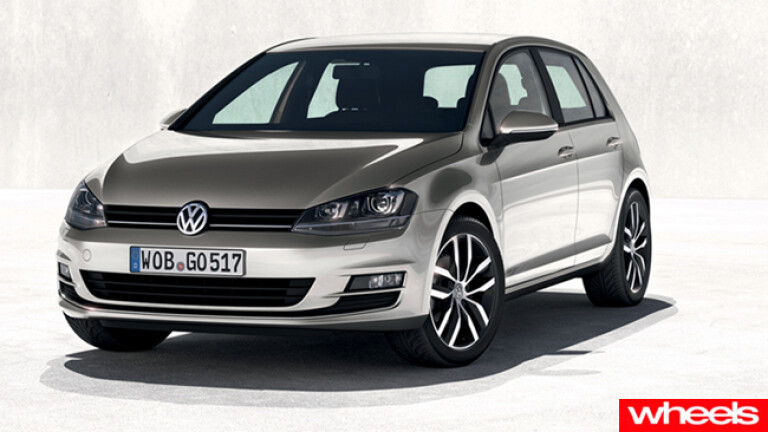
A full five years after its release, the current Volkswagen Golf Mark VI remains the Wheels small-car leader. So what chance does this all-new Mark VII version – larger yet lighter, more powerful and more efficient – have retaining class honours? Par for the course, you’d have to say.
The exterior is clearly from the Porsche 911 school of evolutionary design, classic Golf but with a fresh, chiselled look that hints at Polo around the front-end, and Passat around the tail-lights. “One of the keys to the Golf’s success lies in its continuity,” reckons Walter de Silva, Head of Design for Volkswagen AG. “Refined”, “tweaked”, “enhanced”, and, predictably, “timeless” are the other designer-ethos buzz words de Silva uses.
However it’s beneath the evolutionary lines and designer-speak that things start to get interesting. On average, the new Golf is 100kg lighter than the old one, despite being stretched by 56mm, widened by 13mm, and lowered by 28mm. That latter figure helps reduce drag by 10 percent, to an aero figure of 0.27 Cd, 0.01 better than the Holden Volt electric vehicle, which is the slipperiest car of the GM world. The Mark VII sits on an all- new platform, dubbed MQB (or Modular Transverse Matrix), the architecture of which has been engineered to suit everything from Tiguan to Passat, and their Skoda and Audi equivalents. For example, most parts from the A-pillar forward, including the powertrain and suspension components, are common to a broad range of models. Think of MQB as a ‘superstructure’, not for its sheer size, but for the breadth of platform-sharing (and, by extension, cost saving) it allows. VW claims this saving allows the (high) cost of top-end technologies and weight-saving componentry to be amortised by sheer, communal-model volume.
The new body structure saves a claimed 37kg, only slightly less than the all-new breed of engines (-40kg). Highlight of the entry-level variants is the 1.4-litre direct-injection turbocharged four-cylinder. Essentially an overhauled version of the current 90kW unit, it now produces 104kW, while two-cylinder deactivation system helps lower combined consumption to 4.8L/100km, a 1.6L improvement. The only current competitor to get close to that figure is the Alfa Giulietta 1.4 turbo, which returns a claimed 5.2L/100km. On the diesel front, a 1.6-litre unit claims 77kW/3.8L/100km, identical to the current Golf Bluemotion; a new 2.0-litre unit produces a more impressive 112kW and returns 4.1L/100km – up 9kW and down 0.8L on the outgoing Golf 103TDI. The multi-link rear suspension design is carried over, but added to the electro-mechanical steering set-up is the option of a variable ratio, for the first time.
Back to the bits buyers see and touch, and the new cabin looks more premium than the old Mark VI, with a larger, colour trip computer screen, standard central touchscreen, and new switchgear the highlights. Unfortunately for those who, like us, see no flaw in a mechanically-operated handbrake lever, the downside is that it has been replaced by a push-button parkbrake. Premium features such as an auto-braking function, adaptive cruise control, a driver alert system, and lane-keeping assistance, will be available on Golf (at extra cost) for the first time.
The current Golf is posting strong sales this year, thanks primarily to an entry sticker lowered from $26K when the Mark VI launched here in mid-2009, to $20,990 driveaway in this month’s round of run-out deals. If the MQB architecture can help reduce costs, then there’s no reason the Mark VII can’t continue its sales stealth against the perennial favourites when it arrives here in March. If it drives as well as its on-paper stats read, then retention of its class crown seems certain.

COMMENTS